Holly’s Challah Recipe
This post may contain affiliate links. Please read my disclosure policy.
This challah is perfection: golden-crusted with a light, airy crumb. My friend, Holly, learned this recipe from the wife of a rabbi, and one day she taught me how to make it. I am forever grateful because it’s so delicious, so easy, and every time I make it, my children think I’m a hero. Also: It makes the BEST French toast.

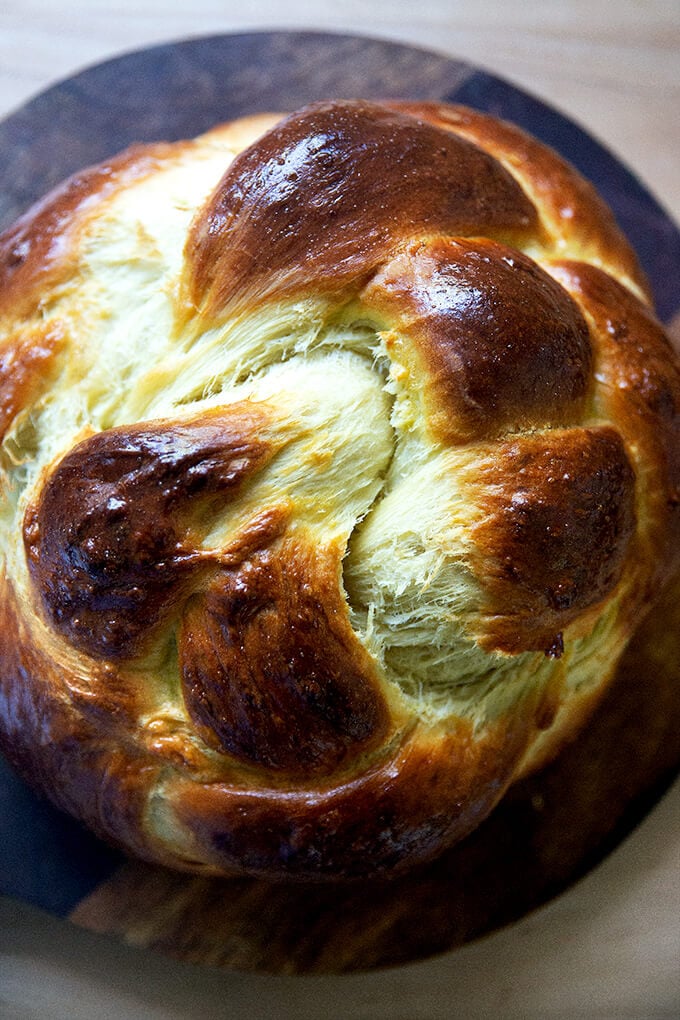
When my friend Holly, one of the most reliable cooks I know, told me she had a great challah recipe, one she learned from a wife of a rabbi, and offered to show me how to make it, I nearly leapt into her arms.
Shortly thereafter on a Friday morning, after dropping the kids off at school, I joined Holly at her house for coffee and a challah lesson. When I arrived, Holly had already made the sponges — 1 cup water, 1 cup flour, 1 packet yeast — which looked alive and ready for action. This is her Friday ritual: make the sponge before dropping her kids off at school; finish the process when she returns.
What I loved about Holly’s challah recipe and process is that it is so simple, so unfussy, so unlike the challah I had been making.
Into each bowl we cracked two eggs, then added the honey, salt, oil and finally the remaining flour. After a brief kneading by hand, the dough was ready to rise. At this point I left, bowl of dough in hand, and completed the process on my own, guidance provided by Holly via text.
The dough rose beautifully and baked into a perfectly golden, light and airy, tangle of braids. Nearly every week since, I have made Holly’s challah, a treat aside any soup (lots of this one and this one these days), a treasure for weekend brunch.
Incidentally, while I was in VT for Thanksgiving, my aunt mentioned she had made a breakthrough with her koulourakia (a twisted Greek cookie): after burning the bottom of several batches, she layered one cookie sheet on top of another, which provided enough insulation to prevent the bottoms from burning. Genius! The conversation immediately made me think of my challah-making trials, a burnt underside almost always a constant.
And so, the day after Thanksgiving, I made a loaf of Holly’s challah for my family, baked the bread on two layers of sheetpans, and for the first time, the bottom of my challah cooked evenly without the slightest sign of overbrowning — a miracle! The Greeks raved! The abstemious indulged! What can I say, Holly’s challah makes me wanna holla holla!
PS: Overnight Refrigerator Focaccia = The Best Focaccia
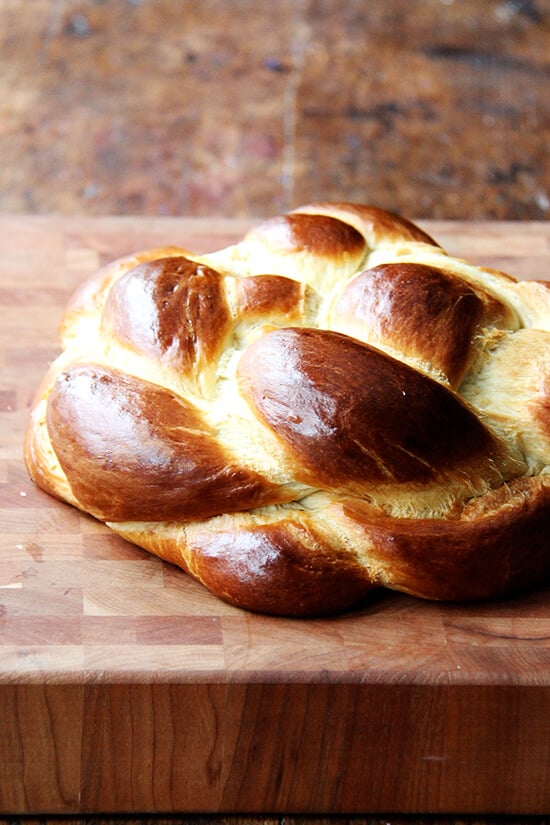
This is what the sponge — 1 cup water, 1 cup flour, 1 packet yeast — looks like after about an hour:
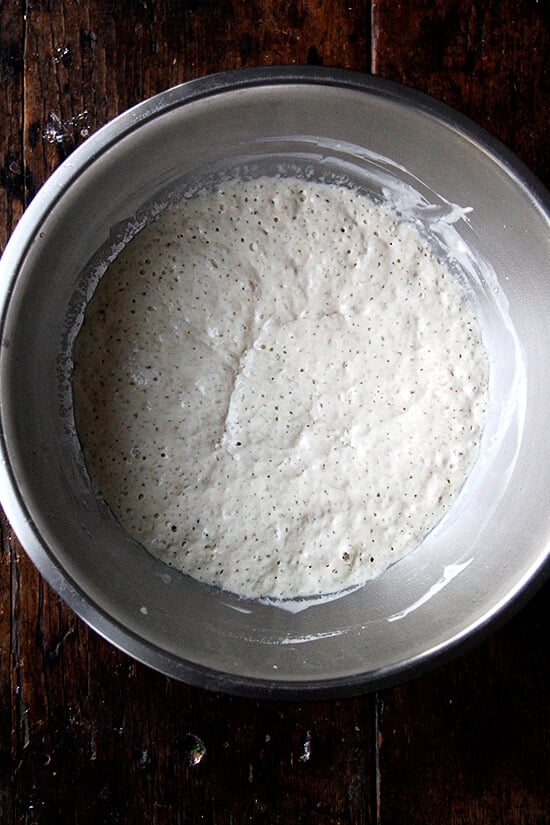
Then, you add the eggs, honey, salt and oil right into the bowl:
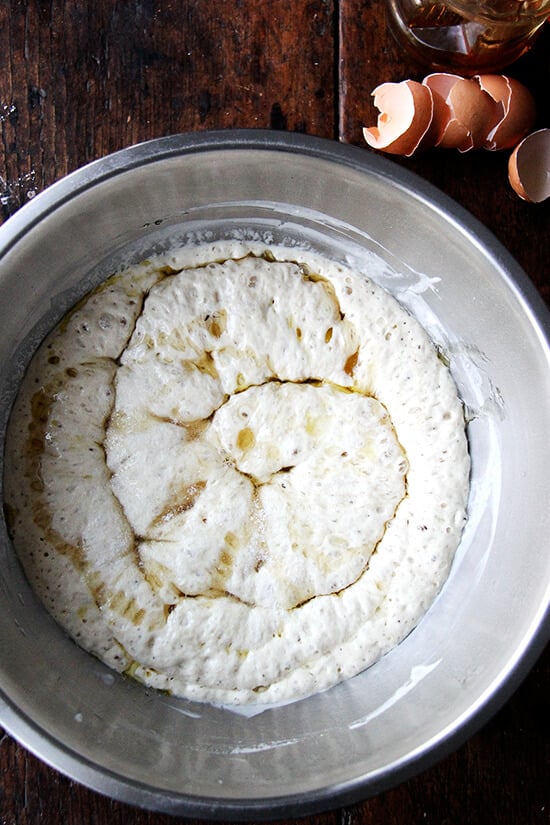
Work in the flour:
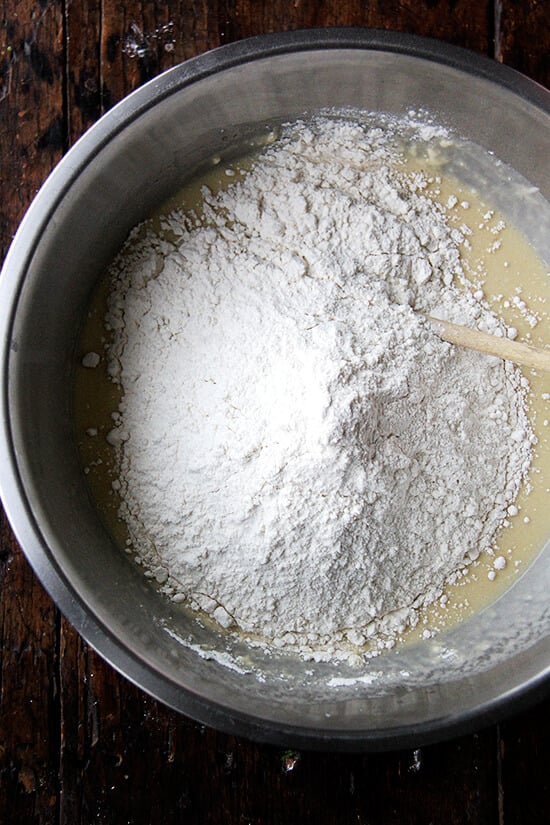
Mix until sticky:
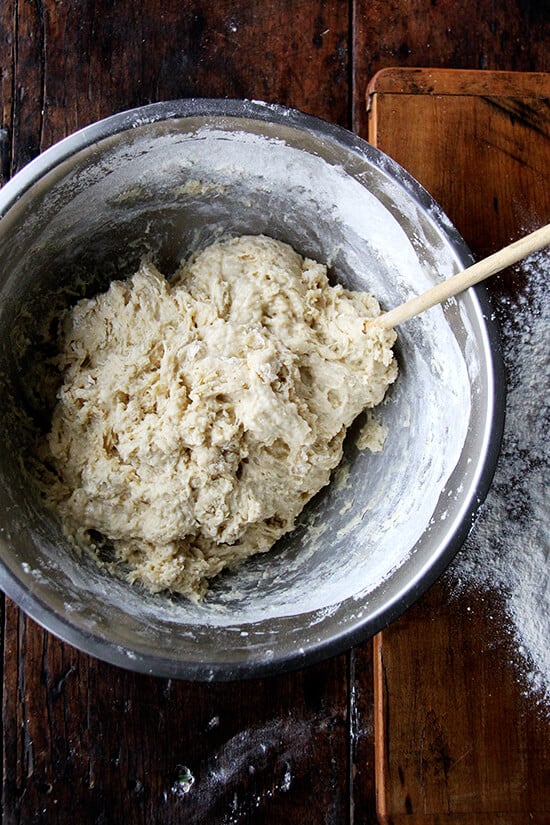
Knead briefly until smooth:
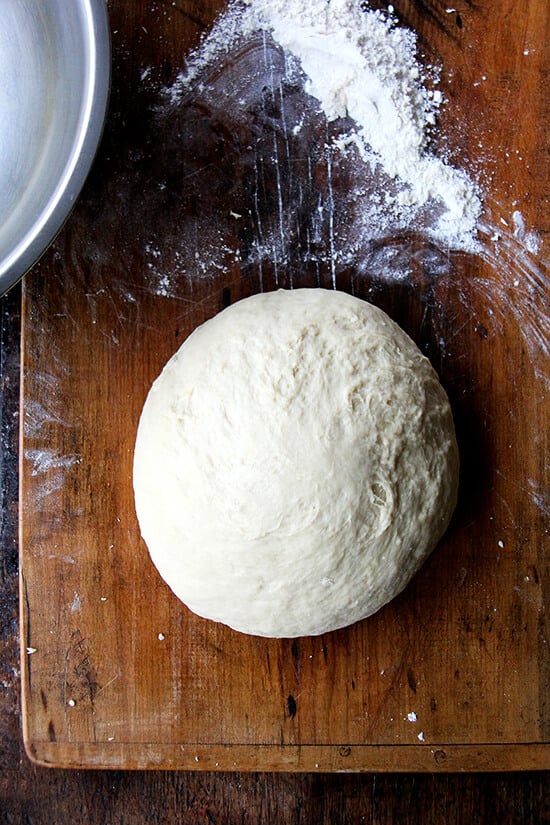
Transfer to an oiled bowl to rise:
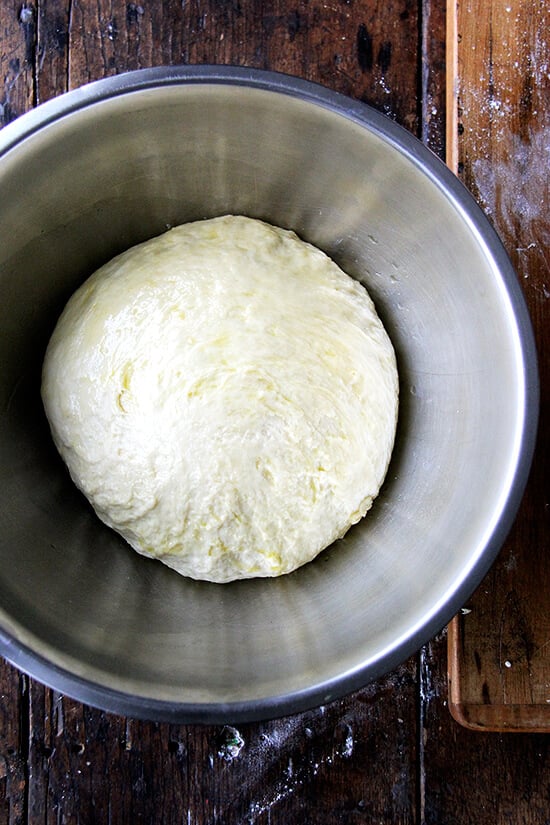
Then wait an hour or two:
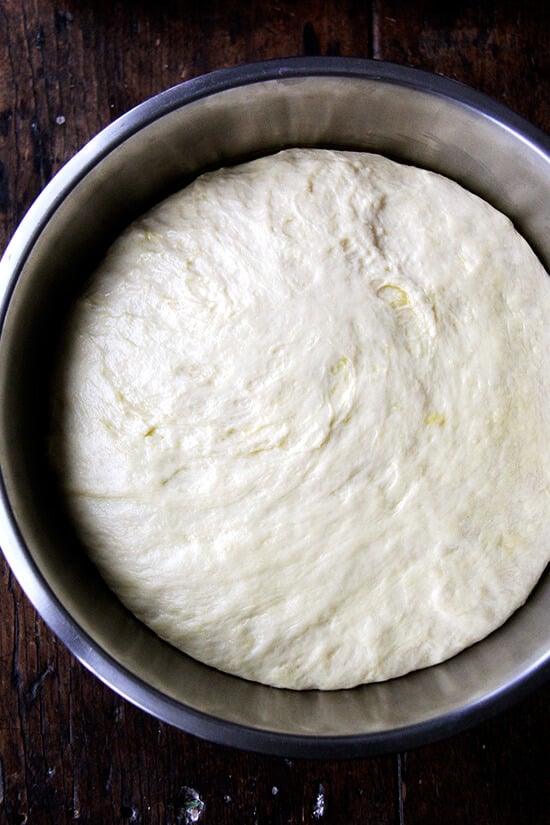
I made a double batch this time, so I divided the dough into 8 portions:
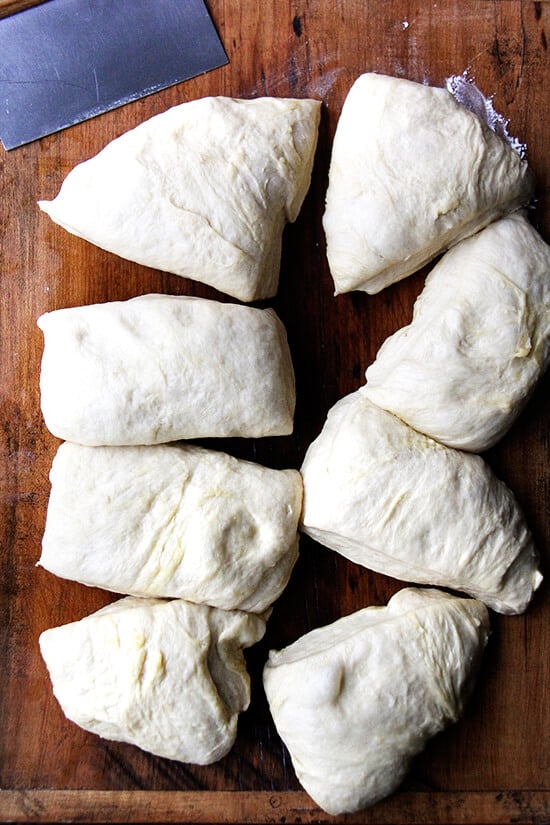
But with a single batch, divide the dough into three or four portions. Be sure to have a helper by your side:
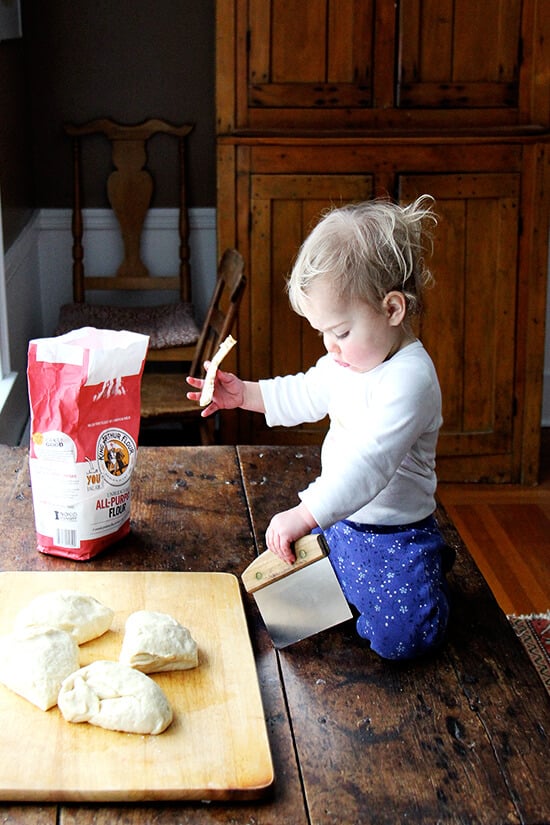
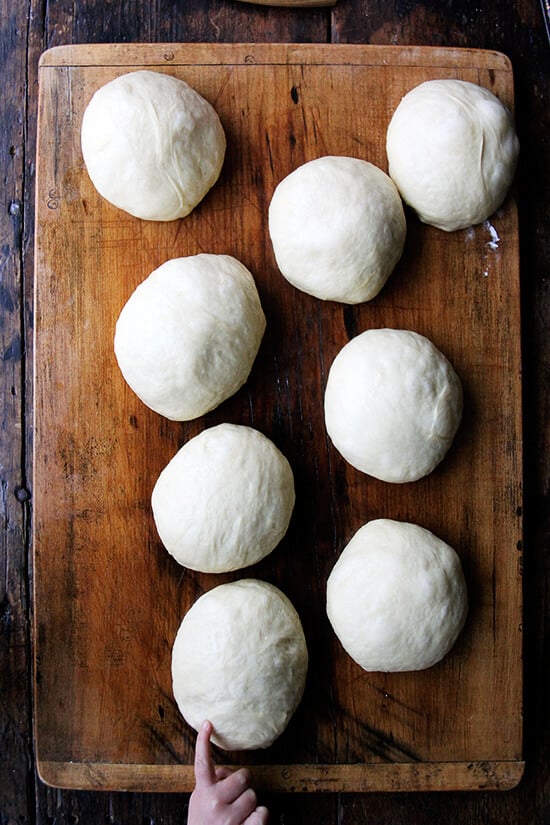
Time to shape! Here’s a quick video on how to shape a round loaf of challah.
And the basic steps:
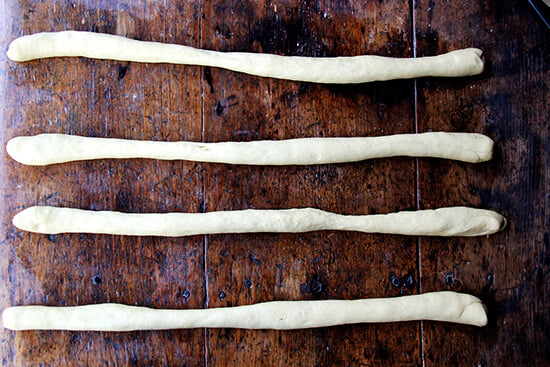
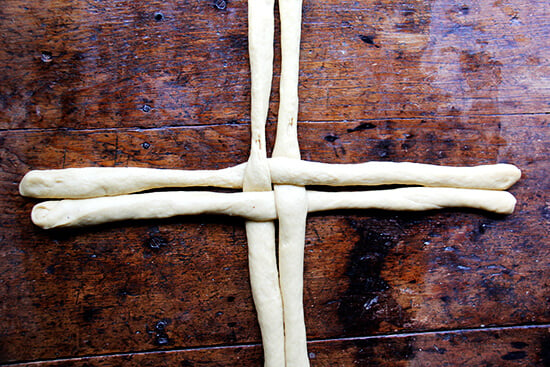
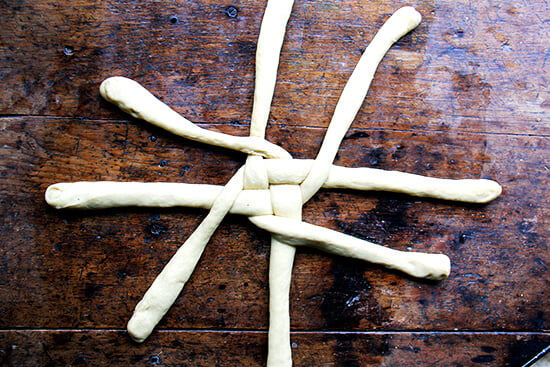
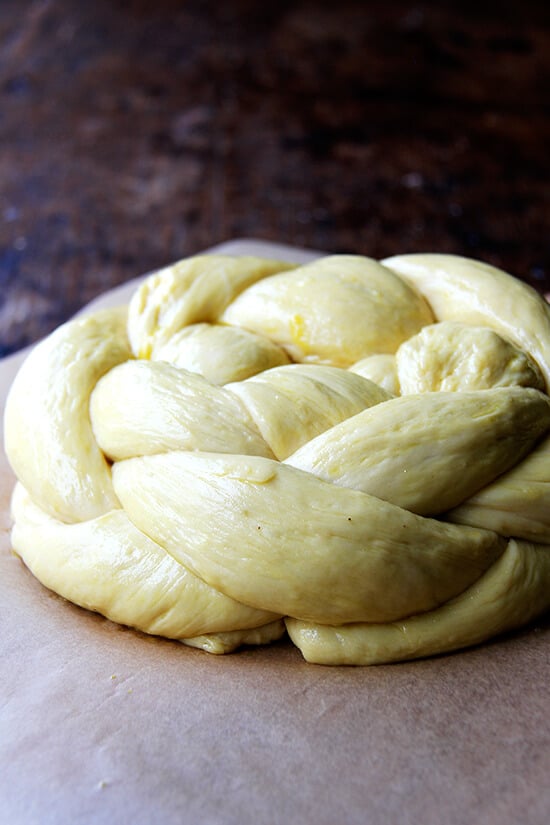
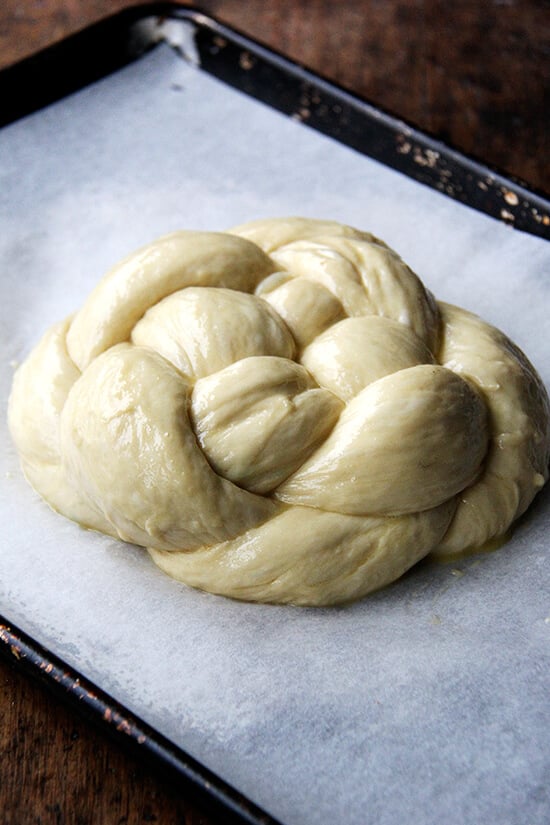
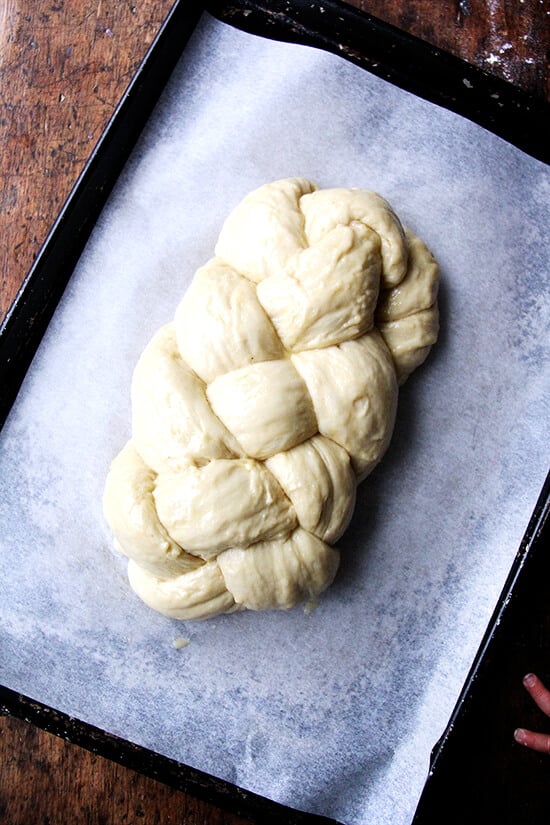
Holly’s is much prettier:
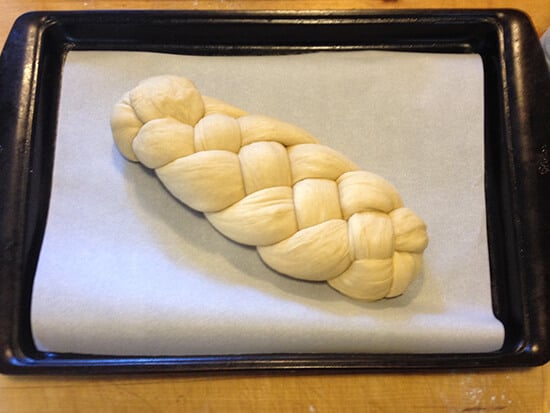
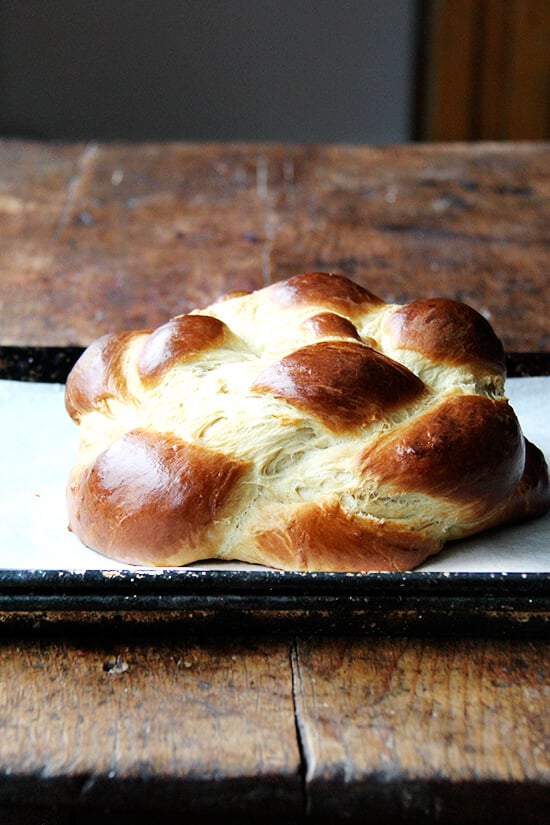
I actually prefer the shape of the more traditional 3 or 4 braid challah for purposes of toast and French toast, but the circular shape is so pretty.
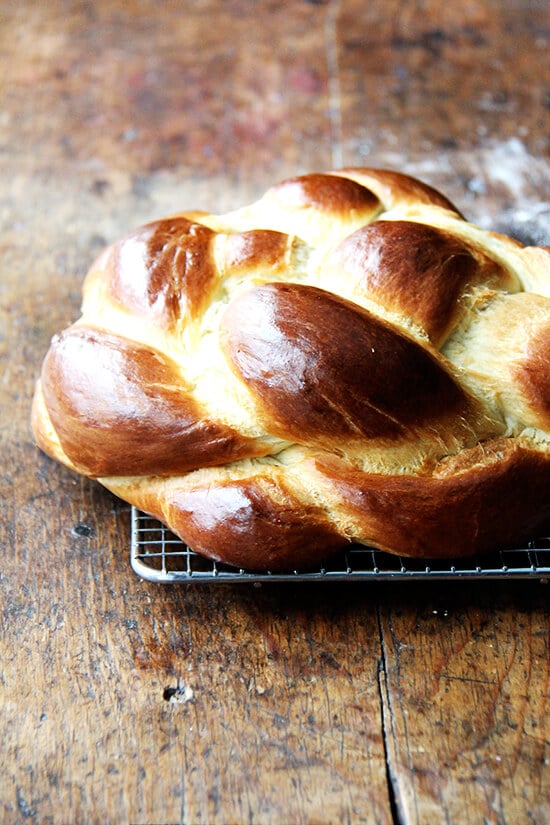
Baking the challah on two sheet pans prevents a burnt bottom:
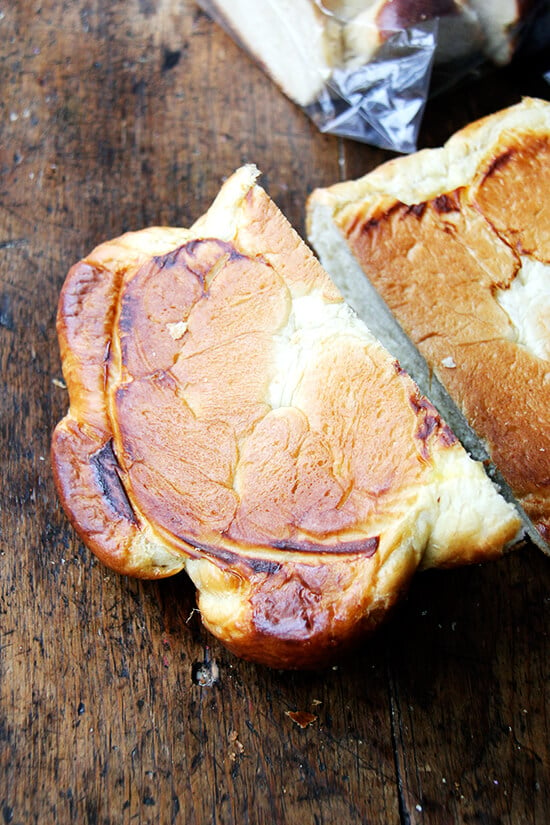
This is day-old challah:
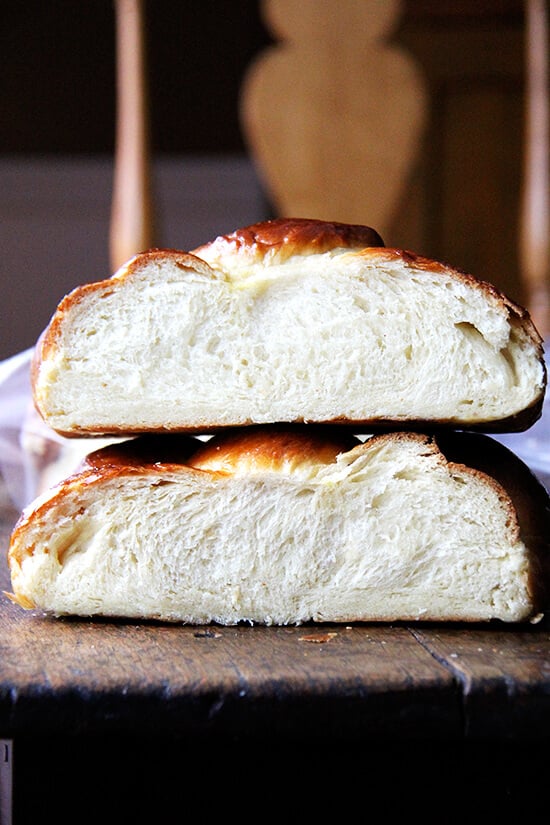
The benefit of making a double batch?
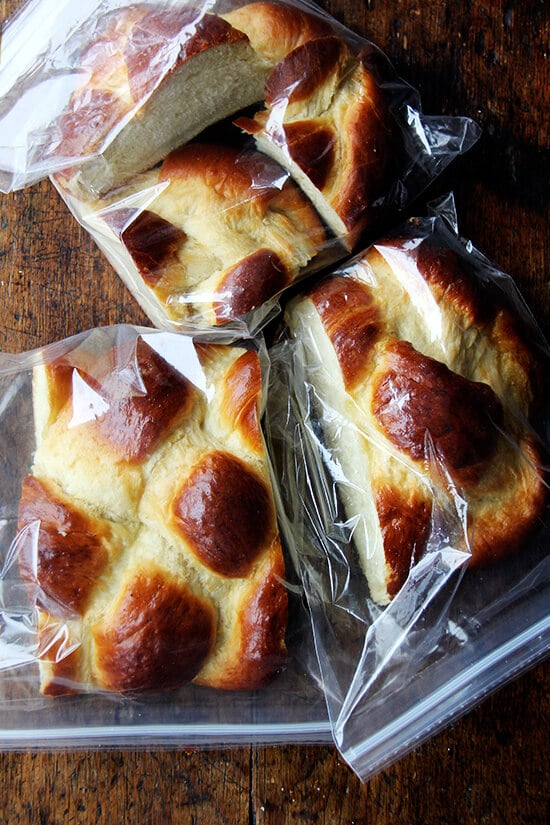
French toast of course.
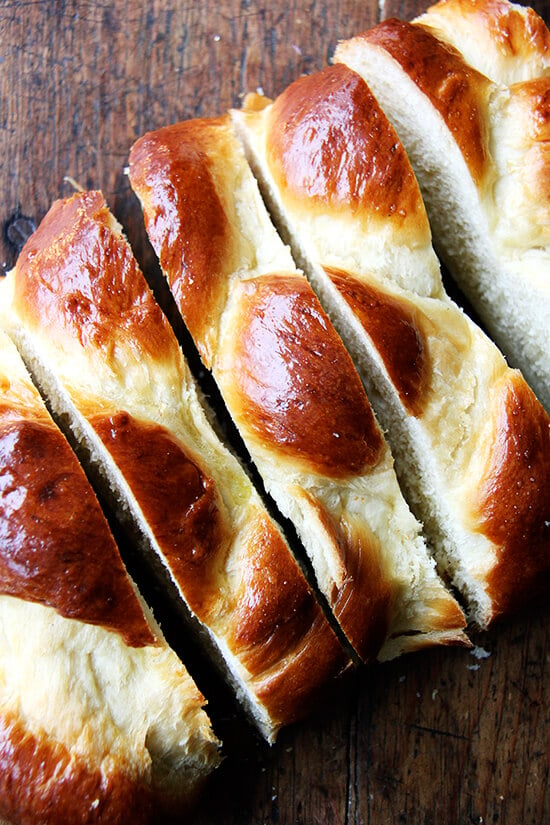
I like to dry out slices overnight:
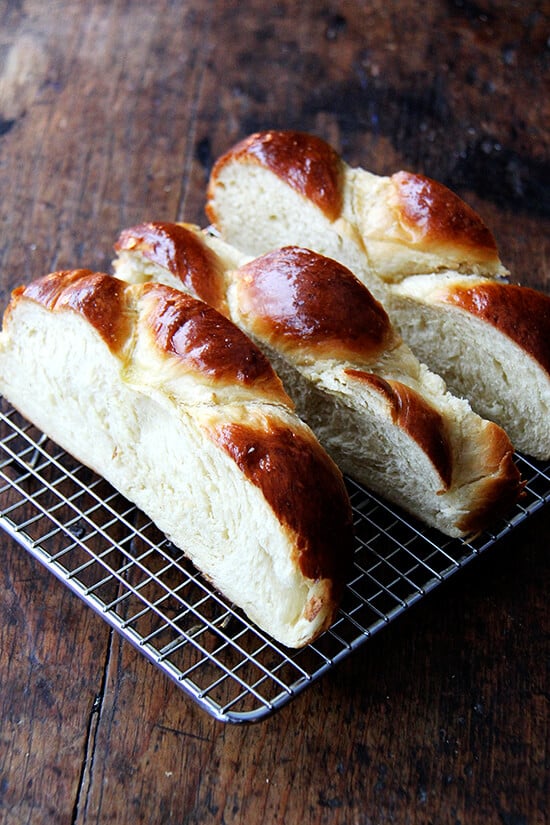
And I love the Tartine recipe, which calls for lots of lemon zest and no cinnamon, but traditional pan-fried recipes work just fine, too. I bet the overnight method would be delicious with challah, too.
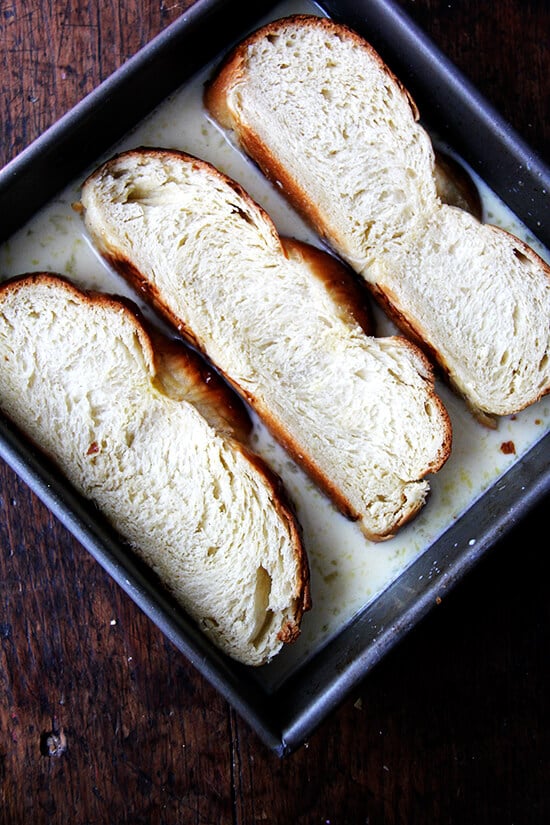
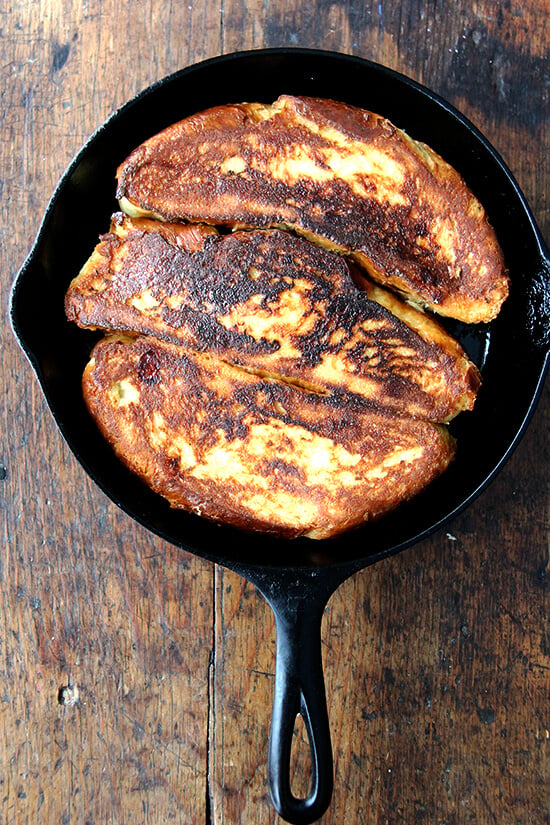
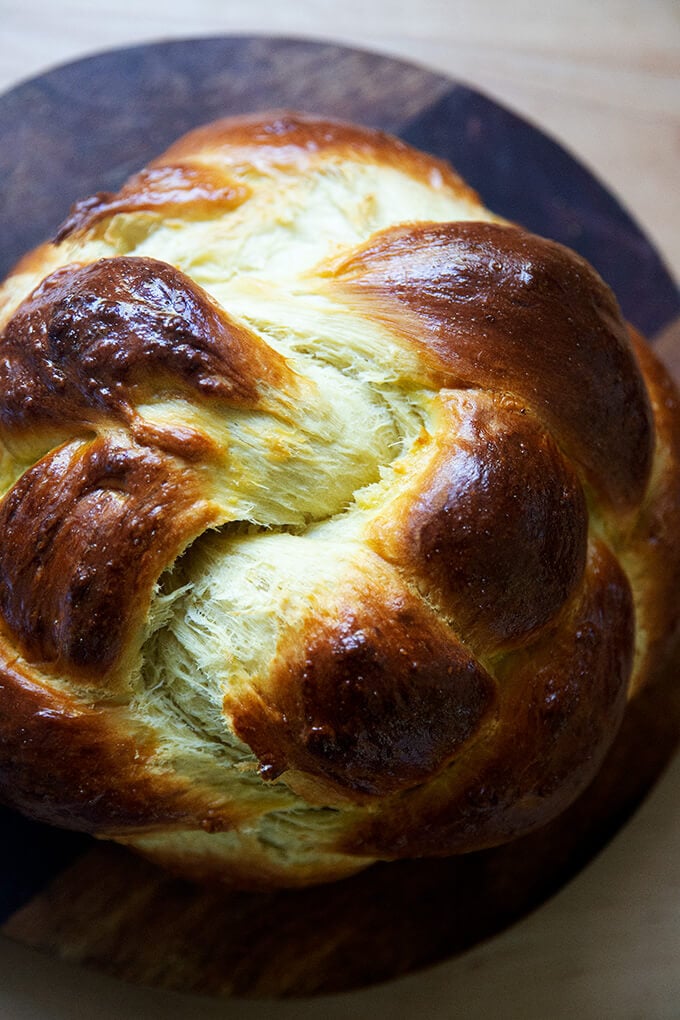
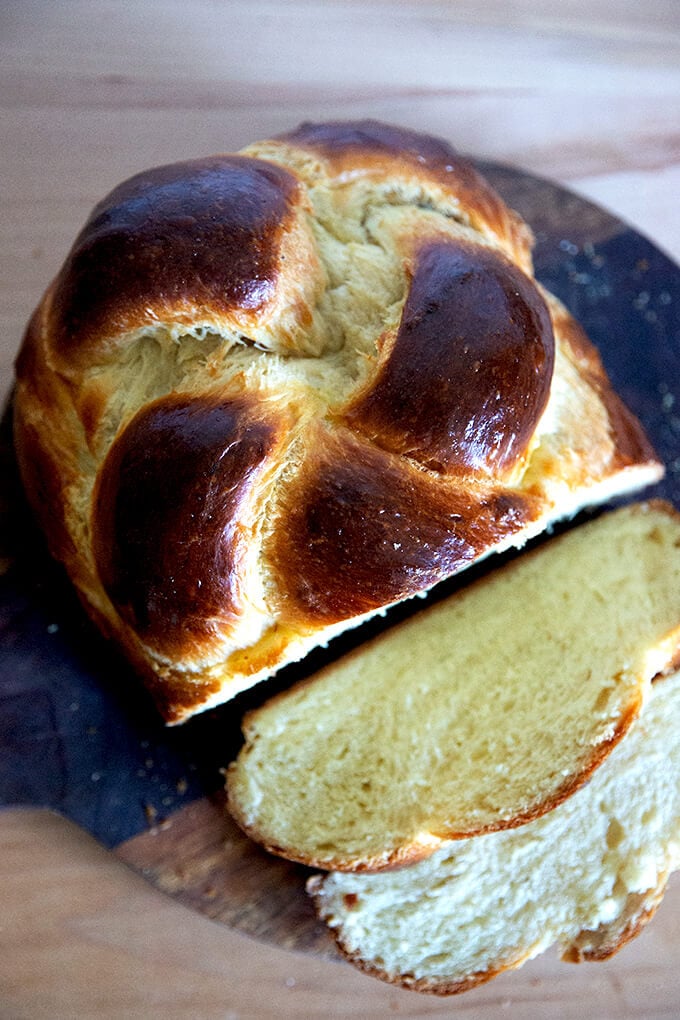
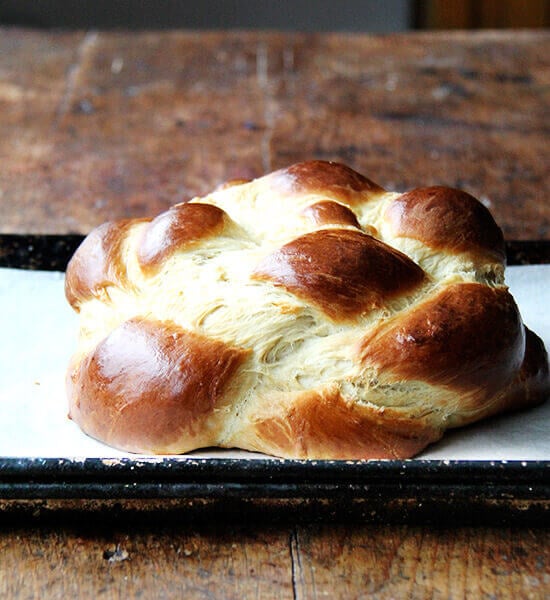
Holly’s Challah Bread Recipe
- Total Time: 3 hours 30 minutes
- Yield: 1 loaf
Description
I learned this recipe from my friend, Holly, who calls it Jennifer’s Challah.
The recipe doubles well. Bread keeps well in a ziplock bag on the counter for several days, and it freezes well, too.
A few notes:
- You can use at least one cup of whole wheat flour or white whole wheat flour. (Holly always does.)
- To create lukewarm water: use ¼ cup boiling water and ¾ cup cold water, which will give you perfect lukewarm water.
- To create a warm place for your bread to rise: Heat your oven for 1 minute, then shut it off. It doesn’t matter what temperature you set it to when you heat it; the key is to only allow it to heat for 1 minute. This brief blast of heat will create a cozy, draft-free spot for your bread to rise.
- A double egg wash creates a beautifully golden and shiny finish to the challah.
- Baking on two sheet pans prevents the bottom of the challah from burning.
- As for shaping, there are lots of resources on youtube. I included one video below for making the entire challah, and a quick gif at the very start of the post, which shows how to shape the round challah.
Ingredients
- 4 to 5 cups (510 g to 620 g) all-purpose or bread flour
- 1 package or 2¼ teaspoons (8 g) instant yeast
- 1 cup (236 g) lukewarm water (made by mixing 1/4 cup boiling water and ¾ cup cold water)
- 1 tablespoon (10 g) kosher salt
- ¼ cup (84 g) honey
- ½ cup (112 g) safflower oil or other neutral oil (canola, grapeseed, etc.)
- 2 eggs
Egg wash:
- 1 egg beaten with 1 teaspoon water
- poppy seeds, optional
Instructions
- Make the sponge: Whisk one cup (128 g) of the flour with the yeast and stir in the lukewarm water until the sponge is smooth. Cover with plastic wrap or a dish towel and let rise about 45 minutes or until puffy and bubbly.
- Directly into the bowl, add the salt, honey, oil and eggs. Stir with a spatula or spoon until well mixed, then add the remaining three cups (384 g) of flour. Stir with a spoon until dough forms a sticky mass. Add a bit more flour, and use your hands to knead briefly in the bowl; then turn dough onto lightly floured work surface and knead for a minute or two, until the dough becomes smooth. Transfer to a lightly oiled bowl, cover it with dish towel or plastic wrap and let it rise in a warm spot until doubled in bulk, one to two hours or longer depending on the temperature of your kitchen. (Note: you can make the dough to this point, punch it down, and stash it in the refrigerator overnight).
- Punch down and divide into three or four parts, depending on what shape you want to make. Roll each portion into a ball. Let rest 10-15 minutes. Roll each ball into long ropes (at least 12 inches in length for the 4-braided challah) and braid into desired shape (see notes above or check youtube). Brush with egg wash.
- Preheat the oven to 350ºF. Let the loaf rise on a greased or parchment-lined baking sheet, about 30 minutes. Place another baking sheet underneath it — this will help insulate the bottom and keep it from burning.
- Brush one more time with egg wash and sprinkle with poppy seeds if you like. Bake for 45 to 50 minutes, checking after 40 minutes. Cool completely before slicing.
- Prep Time: 20 minutes
- Cook Time: 45 minutes
- Category: Bread
- Method: Yeast-Risen
- Cuisine: Jewish
This post may contain affiliate links. Please read my disclosure policy.

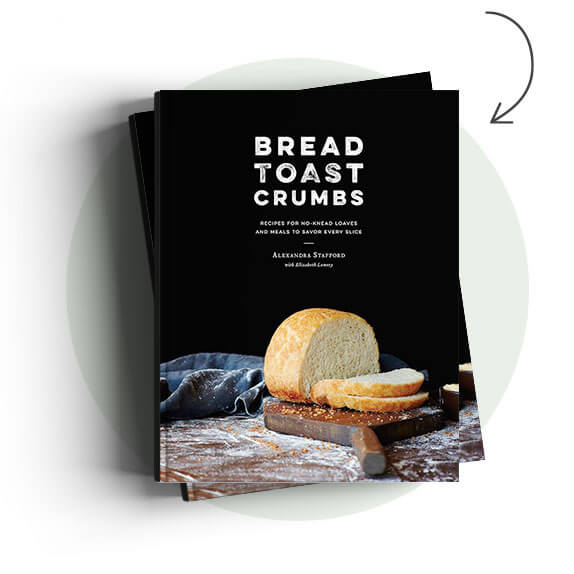

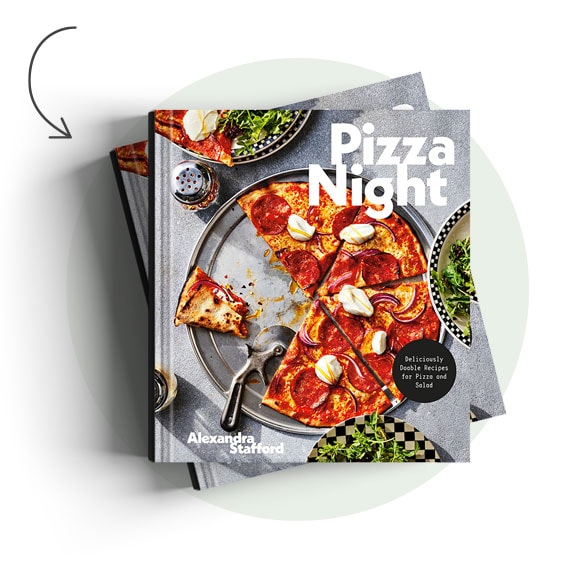
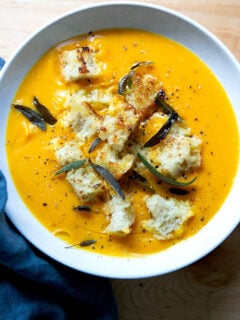
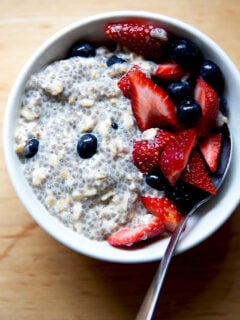
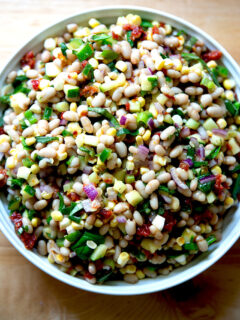
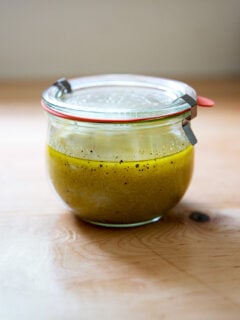
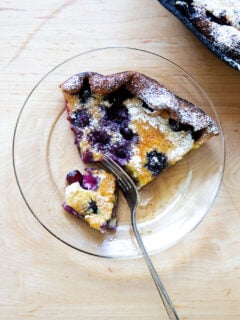
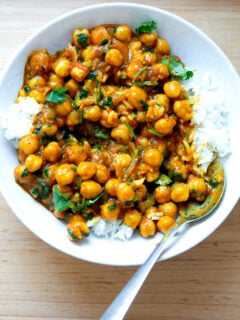

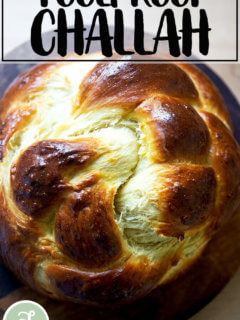
317 Comments on “Holly’s Challah Recipe”
Another delicious recipe! Saw this pop up on YouTube this morning and thought it would be fun to try out. Easy to follow, especially for this first time “braided” bread maker. Sourdough, focaccia, peasant bread and now this. Thanks for another great bread!
So great to hear this, Brian! We have been on such a challah kick this past week … kids love it warm with butter but it’s also just great for toast and French toast, too. So glad you like this one. Thanks so much for writing!
Hello Alexandra,
I have made this recipe many times before and I love it (along with so many of your recipes). Today I was thinking of using a combination of KA All Purpose and KA Bread Flour. Do you think this would still make a good loaf or do you not recommend using both? ( I do have enough of both types, so that is not the issue – just thought I might try it). Many thanks!
Vinita
Absolutely! You can use all bread flour or all ap flour or a mix of the two here. I think my friend Holly almost always uses bread flour.
I think the French toast situation has me a believer in Challah bread!! This was the best French toast I’ve ever had!!
Yay! So nice to hear this, Blair!
After making so much sourdough these days, a quick yeasted bread like this is such a pleasure! It baked up beautifully and I can’t wait to cut into it.
Andrea, I couldn’t agree more 🙂 🙂 🙂
We’re already halfway through the loaf! So much for french toast! I guess next time I will have to double the batch as you recommended ☺️
I must admit, even though this loaf is beautiful and delicious, I keep wanting it to be vasilopita (St Basil’s Bread) Have you made it before? We usually only make it at New Years or Easter but it’s soooo yummy.
Andrea, I can’t believe this, but I have never made vasilopita! I need to honor my Greek heritage and make it ASAP. Do you have a favorite recipe?
And I know, the past few times I’ve made this, I haven’t made a double batch, and I’ve regretted it each time.
I will try to transcribe ours and send it to you! It’s one of those recipes that doesn’t really have instructions because we’ve made it so many times we just “know” what to do. It also makes a TON so I’ll see if I can’t pair it down to something more manageable too. 🙂
Thank you, Andrea!! Absolutely no rush … I know you are busy. Looking forward to it whenever you get around to sending it, but again, please don’t rush 🙂
LOVE THIS RECIPE!!! So easy and fun to make. I like to serve it with a honey butter, it’s almost like dessert:) a very impressive food gift as well!! Thank you Holly (like the name by the way😉)
Holly
Honey butter sounds amazing! So glad you like this one, Holly 🙂 🙂 🙂
This was the best challah I’ve ever made! Great texture, delicious, and so easy. Thanks so much Ali!
Wonderful to hear this, Patti! We have been on such a challah kick here. My kids love it 🙂
I made this Monday and we broke our Yom Kippur fast with the challah and honey. Delicious way to start a sweet new year.
My family really loves chocolate chip challah and I like challah with golden raisins. I’m wondering at what step I should add the chips or raisins to the dough. I tried putting chips into the dough before it rose but that was a melty mess. Any suggestions please?
Thanks so much,
Patti
Hi Patti! So nice to hear this.
I would sprinkle the chips or raisins over the dough after the first rise, and gently knead the dough to incorporate them into it. Raisins, you could actually probably just add with the flour.
Just made the challah yesterday with your instructions and came out AMAZING!!
If raisins get added to the flour will the raisin alter any of the hydration? Or should the raisins be soaked in hot water before adding?
No need to soak the raisins first! And no need to change the hydration either. Great to read this, Eden!
Alexandra, this was my first time and now I’m a believer. I can’t wait to try the French toast. I finished a big chunk of the loaf eating it plain and even more sopping up some vegetable soup.
Your friend calls it Jennifer’s Challah, you call it Holly’s Challah Bread Recipe and I’ll call it Alexandra’s Challah Bread and say it with the cadence and authority of a Alexander Hamilton’s musical. Cheers
Frank! You’re the best. Love this so much. I have not been able to get the Hamilton songs out of my head since July 4th weekend … so good. So glad you liked the challah! Can’t wait to see and hear how you transform it into French toast. Thanks for writing!
This recipe sounds delicious. I will use it for my next Challah. There is something that caught my eye and even made me smile. In this recipe 1 cup of water weighs 236 grams because you use US cups (I appreciate the equivalence as my local cups are 250 ml).
But then, in my go to recipe for no-knead bread, https://alexandracooks.com/2012/11/07/my-mothers-peasant-bread-the-best-easiest-bread-you-will-ever-make/ , 2 cups of water weigh 454 grams.
Could you please PLEASE explain the weight difference to me? Which equivalence is correct?
Hi Vivianne! Honestly, when I first made each of these breads, the original recipes were in volume units. So when I converted them to weights, the weights I came up with were just how much the 1 cup of water weighed that day… hope that makes sense. It’s unfortunate that I haven’t been completely consistent with my weight measurements across the recipes on this site, but if you follow the weights listed for each specific recipe, you’ll be fine. So for this one, use 236 grams.
Thanks for kind reply. I will do as you suggest. To be honest also for the peasant bread I use the 1 cup = 236 grams of water and the bread is delicious. Such an easy recipe!
Maybe this is a useless piece of information but also King Arthur converts 1 cup water to 227 grams. So does the book “The new artisan bread in 5 minutes a day”.
The only explanation I can think of is there is some mish mash between fluid ounces (volume) and ounces (weight). 8 fluid ounces (volume) of water weight 236 grams but 8 ounces (weight) of water are 227 grams only.
Not useless at all! So helpful. Thanks so much for sharing. So glad the peasant bread works out well with a slightly different water quantity … it is very forgiving 💕💕💕💕💕💕💕
I love this recipe! I am making it for a second time this week for Shabbat. was in search for perfect “family recipe” and I think this is it! For rosh hashana and adding in raisins etc, when would you suggest adding them / how much? Thank you !!!!!
Hi Jillian! Wonderful to hear this. I would add the raisins right to the flour and toss them to combine. As for the amount, I think a cup would be about right.
“Better than from a bakery,” my friend said when I gave her a loaf. The bread was PLUSH, first time I’ve ever used this word to describe bread. I had fun learning to braid a round challah. Even my Jewish friend was impressed. Two questions, though: Do you discern any better flavor after an overnight cold rise? And how long do you let it rise (proof) after braiding from a cold rise? The instructions said about 30 minutes after a warm rise. I wasn’t sure if it had to double in size but with a cold dough, I let it proof for about an hour in a cold-ish kitchen before putting it into the oven. It rose well.
So great to hear this, Wendy!
Honestly, I do not discern any better flavor with an overnight cold rise. I do with other breads, but I think with challah, because of the enrichments — eggs, honey, oil — it kind of masks any nuances in flavor lent by a longer, slower fermentation.
But if you want to give it a go, I think 30 minutes is still about right, but touch it, and make sure if feels a little soft and bouncy. If you need to let it rise 45-60 minutes, go for it. A lot will depend on the warmth of your kitchen. I find dough that I braid (probably because of the handling) comes to room temperature more quickly than bread I just pull out to rise.
Hope this makes sense! Thanks for writing!
Alexandra,
My very best friend (since we were 15), moved to Ireland earlier this year. She hosted an open door shabbat dinner, for decades, for our group of friends. Since then, we’ve been staying in touch virtually. We still have dinner and share recipes. She shared this one with me. OMG! I actually cried when I pulled that first loaf out of the oven. It was the prettiest thing I’ve ever made. I never even got a slice, it was devoured so quickly. I’ve now made loaves for all my neighbors, for the holidays; I’m trying the babka now. I’ve ordered your cookbook, and can’t wait to get cooking. Thank you, thank you, thank you 😊
Awww Jennifer, this means the world to read 🙂 🙂 🙂 Thanks so much for writing and sharing all of this. I think there is no better gift than the gift of homemade bread. What lucky neighbors you have. Thanks again for writing.
Your kneading steps don’t seem very long. How do I know when fully kneaded?
Hi Larry! Yes the kneading is very brief — you’re really just kneading until the dough loses its stickiness. If you skip ahead to 1:41 in the video, that might give you a visual. This is not a dough you use a “windowpane” test on or anything similar. It’s definitely on the sticky side, but kneading briefly helps remove the extreme stickiness — when it’s sticking to your work surface and hands.
Summary: thank you so much for the recipe! Mine didn’t brown as much as I had hoped, and also didn’t rise during proof, any advice?
My challah didn’t rise during the 1-2 hour proving period, any insight? I ended up leaving it for 2.5 hours total, but no change 🙁 I don’t think the yeast was expired/inactive because I had bubbles in my sponge and everything looked right (until I plopped it in a bowl to prove). I live in a rainy, humid area, so I did about 40 mins of proving in the 1-min heated oven and then the rest of the time outside (not really sure why I did it like that, probably not that smart in retrospect).
It ended up being pretty thick/slightly damp inside as well, not having the nice open texture of challah (probably because it didn’t double in size). However, it tasted pretty ok (to the amateur palate of me and the family). Trying again soon with any advice you have!
Hi Annika! This is so strange. I am sure the texture issues have everything to do with the dough not rising. So something definitely went wrong in the early part of the process. What kind of yeast are you using? Are you using a scale to measure? Did you reference the video in regard to how bubbly the sponge should look? And did you use lukewarm water (1/4 cup boiling to 3/4 cup cold …. sometimes people reverse those two numbers and the mixture is too hot and it kills the yeast)? Have you had success using your yeast with other bread recipes?
I used dry active yeast, so I multiplied the quantities for the yeast by about 1.25 and added a little extra water. I used scales for everything (my most used baking purchase) and my sponge looked just like yours in the video. I am certain that i used the correct cold-boiling ratio as I was so intrigued by it! I have had success using this yeast (albeit, not recently), but the bubbles have to mean something, right?
If there’s anything in there that looks wrong, I will be such a happy camper to find an easy fix!
Nope, this all sounds right!
I really am perplexed. My only thought would be for next time, to let the first rise go longer, until you really see it double in volume. And same with the proof: wait a little longer until the dough looks noticeably puffier before putting it in the oven.
Sorry this one didn’t work out! I hope next time does 🙂
Hi,
The bread looks amazing and so delicious !! I want to make this bread, is there any way I can use the hand mixer when it comes to the part that is kneading the dough by hand in the video clip? How long, or how many minutes should I use the hand mixer to mix the dough and at low speed?
Thanks
Hi Helen! Sure! I would mix for no more than 5 minutes.
What are your thoughts on baking in a convection oven? I am reading it’s better to do it there but requires lowering by 25degrees and reduction of time by 10minutes.
Hi Karen! It’s worth a shot. As I understand, convection ovens or the convection setting will brown things more quickly, because the air circulates more quickly. I was told never to use it with cakes, because the air can swirl the batter. It may be fine with bread, and your notes about lowering the temperature and decreasing the time sound right. I think it’s just all about experimenting and adjusting based on your results.
Hi Alexandra,
I made this challah today. It taste so so good with the perfect sweetness !!! The texture is soft, puffy, and slightly chewy. This is what I was looking for. Thank you for another delicious recipe. I also loved your focaccia bread.
I want to do an overnight rise dough in the fridge. Please can you tell me, is this the procedure :
1. After kneading the dough and 2 hours rise on the counter, put the dough in the fridge.
2. Next day, take the dough out of the fridge. Proceed with shaping the dough, into a braid which takes about 30 minutes to 45 minutes.
3. Next, do an egg wash and allow the dough to rise 30 minutes.
4. Then , do a second egg wash and bake in the oven
Wonderful to hear this, Helen!
Yes, you’re overnight process sounds great. A few thoughts: After the first rise on the counter, deflate it/punch it down and shape it into a ball. Also, slick the dough with oil and cover it tightly with plastic wrap or place it in a container with a lid — this will prevent a crust from forming on the dough overnight. Everything else sounds great!
Hi Alexandra,
This time, I made your bread into a loaf with overnight rise in the fridge. OMG it is SO SO DELICIOUS !!! It is fluffy, soft, sweet and slightly chewy all at the same time.
I would like to make it slightly sweeter without changing the texture of this bread. I would like to I add half a tablespoon more honey, or half a tablespoon sugar to the flour mix. Would the additional sugar or honey affect the texture of the challah bread? How can I maintain the same texture with the additional honey or sugar ? Thank you for your time.
Hi Helen! Wonderful to hear this! I don’t think 1/2 tablespoon more honey will affect the texture. Go for it!
Made the challah bread for the first time….very pleased with the result. It tastes delicious.
Thank you for your very helpful video and clear instructions.
So nice to hear this, Anita! Thanks for writing 🙂
Great challah bread recipe! When I started baking bread, I discovered that challah made a truly impressive loaf that was delicious. I discovered this when I was looking for a honey challah. I have always made challah with 1/2 whole grain. With this one I tried a sprouted whole grain spelt – it makes a great loaf. I also use a 3 braid and bake it in a 9X5 loaf pan, which gives a beautiful shiny loaf (I can’t resist using poppy seeds to guild the loaf). Years ago the Jewish mother of a friend loved my challah which she called “Cholly” bread, so I think of this as Holly’s Cholly Bread. Thanks.
Holly’s Cholly Bread is even better! I love this so much. Thanks so much for writing and sharing all of this. I can’t wait to make this in a loaf pan.
Have never made Challah before and found your recipe! So easy to follow and it turned out perfectly!! I’m chuffed with myself! Definitely can’t take all the credit as it was all down to your recipe!! Thank you so much for such an awesome recipe! Might have been my first time making but certainly won’t be my last!! Yippppeee!! Now my family can stop sending me loaves from Australia because I can make my own!!!!!
Oh yay! Maggs, so great to hear all of this. I LOVE that your family was sending you bread from Australia. That’s dedication 🙂 🙂 🙂
This bread is fabulous! I made two loaves today, one round and one braided, and my family loved it! I’m going to make another loaf tomorrow for my neighbor because I’m so excited to share! Thank you!!
So wonderful to hear this, Connie! Thanks so much for writing. There’s nothing like sharing freshly baked, homemade bread 🙂 🙂 🙂
Hi, just wondering how many millilitres or grams is ¼ cup honey and ½ cup safflower oil from the recipe? I don’t have measuring cups but a digital kitchen scale.
Hi Katie! This is based on a Google search:
1/4 cup honey = 85 grams
1/2 cup oil = 108 grams
Okay, thanks! Just made it and it turned out better than expected!
Great to hear, Katie!
I can’t wait to try this recipe! Can I do the whole thing in my kitchen aid mixer with the dough hook? And skip all kneading by hand?
Yes, you can! Good luck!
Hi there
I love your site and have your book – so thank you!!
question for you. I would like to make both the challah as well as challah buns. How long would I bake the buns for?
thanks in advance
Sandy
Hi Sandy! So nice to hear this. Question regarding the buns: how big are they? As in, are you dividing this dough into fourths or sixth, etc? And do you bake the challah buns free-form on a sheet pan or in muffin tins?
Diving dough into 6ths. Using a spring form round pan
OK, fun! I imagine the timing will be about the same. Sorry for so many questions here, but are you going to divide the dough into 6ths, ball it up, then transfer to the springform pan? If so — as in, if the same amount of dough that makes 1 loaf is all going to be together in the springform pan — then I think the timing will be similar. I would start checking at 30 minutes, and just keep an eye on it. The rolls might take less time, but I can’t say for sure.
Dear Ali,
This is one of my kids favorite of all your recipes! I usually bake right through the recipe, but tonight must stop and refrigerate my dough overnight. I’m in step 2, BUT before the 2 hour rise. Do you have any tips on what to do tomorrow when I remove dough?
Thank you for everything!
Maureen
Hi Maureen!! So sorry I’m just seeing this. What did you end up doing?
What I would have suggested is just to play it by ear: sometimes dough rises a lot in the fridge. If this happened, I would punch it down and proceed with the recipe. If it still looked as though it needed to rise more, I would let it rise at room temp until about doubled; then proceed with the recipe.
Hi again,
I must have channeled you 🙂 and it was a success! The dough had risen a lot during the slow cold overnight rise so I did proceed. The dough did not rise as much as usual in the second rise so the loaf was shorter and wider in shape. It wasn’t the prettiest challah, but it was equally delicious. My four little ones polished it off as toast and then french toast. Thank you as always!
Take care,
Maureen
So nice to hear this, Maureen! My four littles love this one, too 🙂 🙂 🙂 Regarding the shorter loaf, it’s possible if — and this is just a note for next time around — you let the second rise go a little bit longer maybe 45-60 minutes, you might get a loftier loaf.
Over 5 years since I discovered this recipe, this is my go-to bread! Soo good! I looked it up again to share with a friend.
So nice to hear this, Stephanie! Thanks so much for writing 🙂 🙂 🙂
This is the best Challah recipe ever. Love the texture and heavenly smell of the bread. The recipe is easy. My family loves it. Barely lasts two days.
So nice to hear this, Helen! Thanks so much for writing 🙂 🙂 🙂
Hi, Ali, I would really like to try challah bread and make the beautiful braiding but I was wondering, would it be OK to substitute milk for water and would the quantity stay the same? I am afraid it would affect the “sponge”, wouldn’t it?
I come from Bulgaria and we make Easter bread (kozunak) using butter and milk (a lot like Greek’s tsoureki).
Thank you in advance! I really enjoy your recipes and guidance!
Hi! I think using milk will work out just fine! Go for it 🙂 🙂 🙂 Thank you for the kind words. Good luck!
Hi. Made this successfully thrice but friend found it a bit sweet. Would the recipe be damaged if I lessened the honey content? And might you have any suggestions on doing so? Thanks
Not at all! Cut it back by as much as you wish. Even using a tablespoon would be fine.